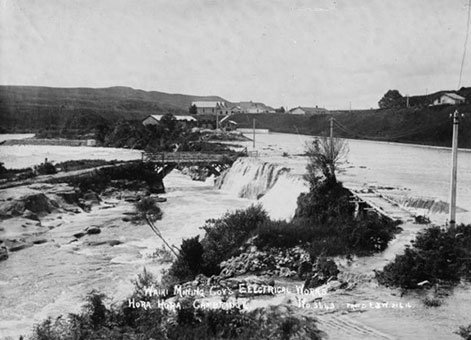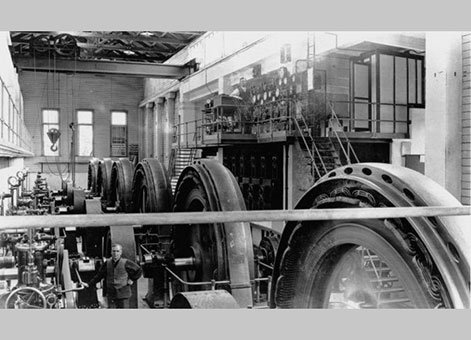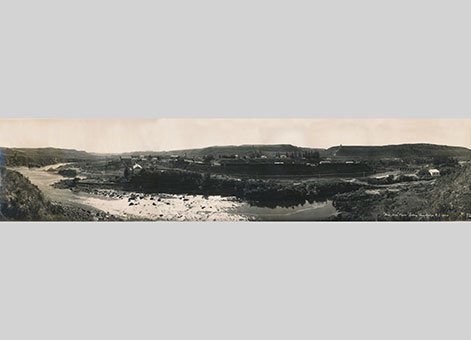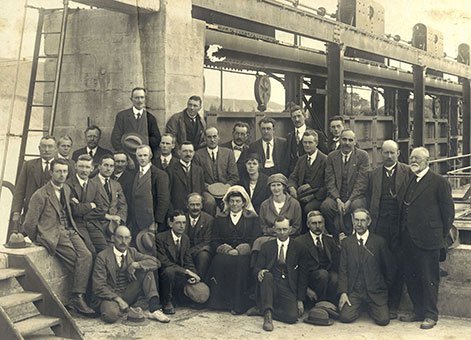Initially commissioned for the Waihi Gold Mining Company in 1914, the Horahora Power Station was submerged in 1947 when the Waikato’s Lake Karapiro was created.
The first attempt to build a hydroelectric power station on the Waikato River at Huka Falls was by Josiah Firth but his proposal was blocked by the Seddon Government in 1886. Around this time the thriving mining industry was becoming an important leader in developing New Zealand’s hydroelectric power potential. Therefore, in 1897 the Waihi Gold Mining Company utilised water from the Ohinemuri and Waitekauri rivers to power turbines directly driving stamping batteries that crushed the gold bearing ore. By 1902, with the doubling of stamping capacity, water turbine driven direct current (DC) generators were installed to supply electric motor power. However, despite the building of a steam driven electric power station in 1905, the company was facing the need for additional and cheaper power to crush lower grade ore.

Waihi Mining company's hydro-electric works at Horahora - Photograph taken by Edward John Wilkinson [21 June 1916]. Ref: 1/2-000894-G. Alexander Turnbull Library, Wellington, New Zealand. http://natlib.govt.nz/records/22431104.
Horahora Power Station’s development
The original survey of the hydroelectricity potential of the Horahora rapids on the Waikato River, about 80 kilometres from Waihi, was completed in 1905 by a Waihi surveyor named Chalmers. The company applied for a licence to develop the Horahora site, but like the earlier attempt this too was declined. At that time government had a firm view that it should develop New Zealand’s hydro potential in the national interest rather than allowing private interests to benefit. However, in 1910 it was finally agreed that the company be given approval to build a station up to 10,000 horse power (hp), with the Government having the right to purchase the complete works at any time at an agreed valuation.
The Chief Engineer for the Horahora hydroelectric development was Mr Gauvain. He was well known in Waihi and Waikino as he was also the Chief Engineer of the Waihi Gold Mining Company. The company's scheme diverted part of the Waikato River's flow by means of a 400 metre (m) canal across a bend in the river, where there was a significant fall of level due to rapids. The powerhouse at the end of the canal made use of the resulting head of 9 m, and discharged the flow back into the river via a short tailrace.
The headrace was cut through an area of gravel and large boulders, and excavation was assisted by sluicing, a technique often used in mining at that time. This canal was concrete lined. A headgate at the top of the headrace was built behind the earth bank of the river, and when the time came, this bank was also removed by sluicing it into the river.

Interior of Horahora Hydroelectric station [circa 1912]. Ref: 1/2-112301-F. Alexander Turnbull Library, Wellington, New Zealand. http://natlib.govt.nz/records/22879893.
By the end of 1911 work was well in hand on the headgates, the canal and the powerhouse building, and by the end of 1912 much of the civil work had been completed. The original installation consisted of six horizontal 1,950 hp Frances turbines with the shaft of each passing through a water sealing gland into the generator room to drive a 1,050 kilowatt (kW) generator. Automatic governors located in the generator room controlled each turbine by radial gates.
Siemens of Stafford, England was selected to supply the generators, transformers, switchgear and switchboards, and Boving and Company of Sweden supplied the turbines and associated gear, such as governors. The installation of this equipment was completed by late 1913. This gave a total station output of 6,300 kW. In October 1913 a groyne (later to be made a weir) was extended into the river just downstream of the headrace gates to divert water into the headrace. This enabled the station to begin commissioning the equipment.
Horahora hydroelectric power station was completed in early February 1914, and its power was delivered to the Waihi mines on 8 April 1914 by means of the just completed 80 km Horahora to Waihi transmission line. At the time this was the longest transmission line in New Zealand.

Horahora Power Station, 1924. Photographer R P Moore. Image courtesy of J La Roche.
Private to public power
In 1919 the Government purchased the station, which was only working at half capacity at the time because of reduced mining load. However, with the expansion of the 50 kilovolt transmission network including connection to Auckland, the Government soon required increased capacity. Between 1924 and 1926 the headrace, tailrace and powerhouse were enlarged to accommodate two additional 2,000 kW units, which enabled an output of 10,300 kW. Electricity was supplied to the public of the Thames district in 1925 after the formation of the Thames Valley Electric Power Board. Power supplies in 1925 were provided to 1,000 milking machines and six dairy factories in the region.
Horahora provided the only substantial hydro generation for the northern part of the North Island until Mangahao and Waikaremoana were connected to that area in 1932, and Arapuni was commissioned and operating reliably in the same year.

New Zealand Society of Civil Engineers Auckland Branch, members and visitors at Horahora Hydro-electric works, 26 October 1919. Engineering New Zealand.
Remnants
Horahora and its headworks were submerged with the filling of Lake Karapiro in 1947. A well-known photo shows the generators still turning as the lake level rise to drown them over the next few days.
One of the original Siemens generator rotors now sits on a terrace above the power station site, marking the located of the former Horahora settlement. This was salvaged, along with other generator equipment, in the 1970s.
More information
References
John E Martin, People Politics and Power Stations, Bridget Williams Books and ECNZ, 1991.
Caudelle Clarke, 'A Short History of Hora Hora and the Hydro-electric Power Development,' Ohinemuri Regional History Journal, 9 May 1968.
J. B. McAra, Gold Mining at Waihi 1878-1952, Waihi, 1998.
Joyce Neill, 'Life at the hydro-electric power project at Horahora,' Ohinemuri Regional History Journal, 21 June 1977.
Additional image gallery details
Waihi Mining company's hydro-electric works at Horahora - Photograph taken by Edward John Wilkinson [21 June 1916]. Ref: 1/2-000894-G. Alexander Turnbull Library, Wellington, New Zealand.
Interior of Horahora Hydroelectric station [circa 1912]. Ref: 1/2-112301-F. Alexander Turnbull Library, Wellington, New Zealand.
Permission of the Alexander Turnbull Library, Wellington, New Zealand, must be obtained before any re-use of these images.
Location
The site now lies under Lake Karapiro adjacent to Horahora village about 20 kilometres southeast of Cambridge.
